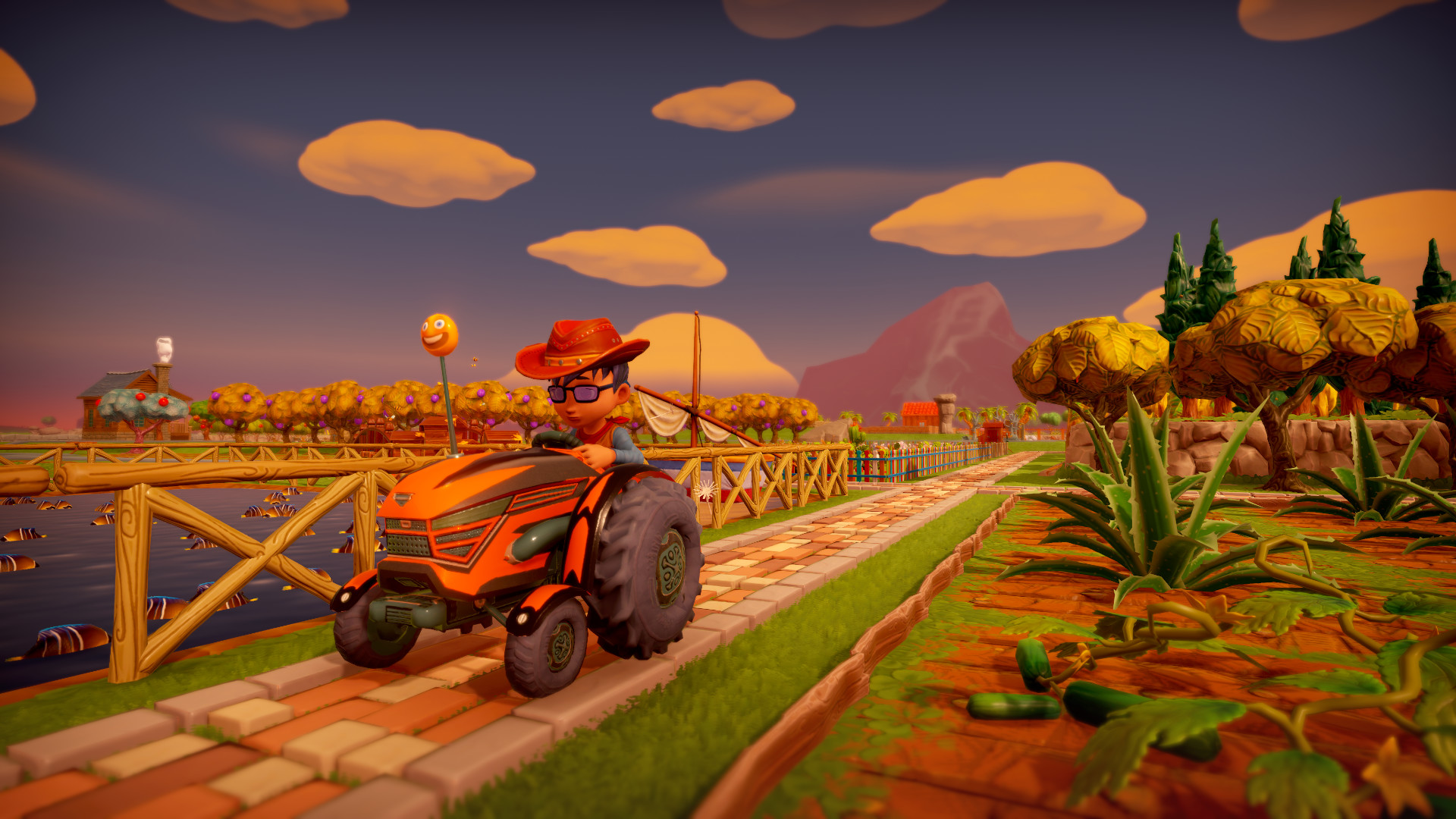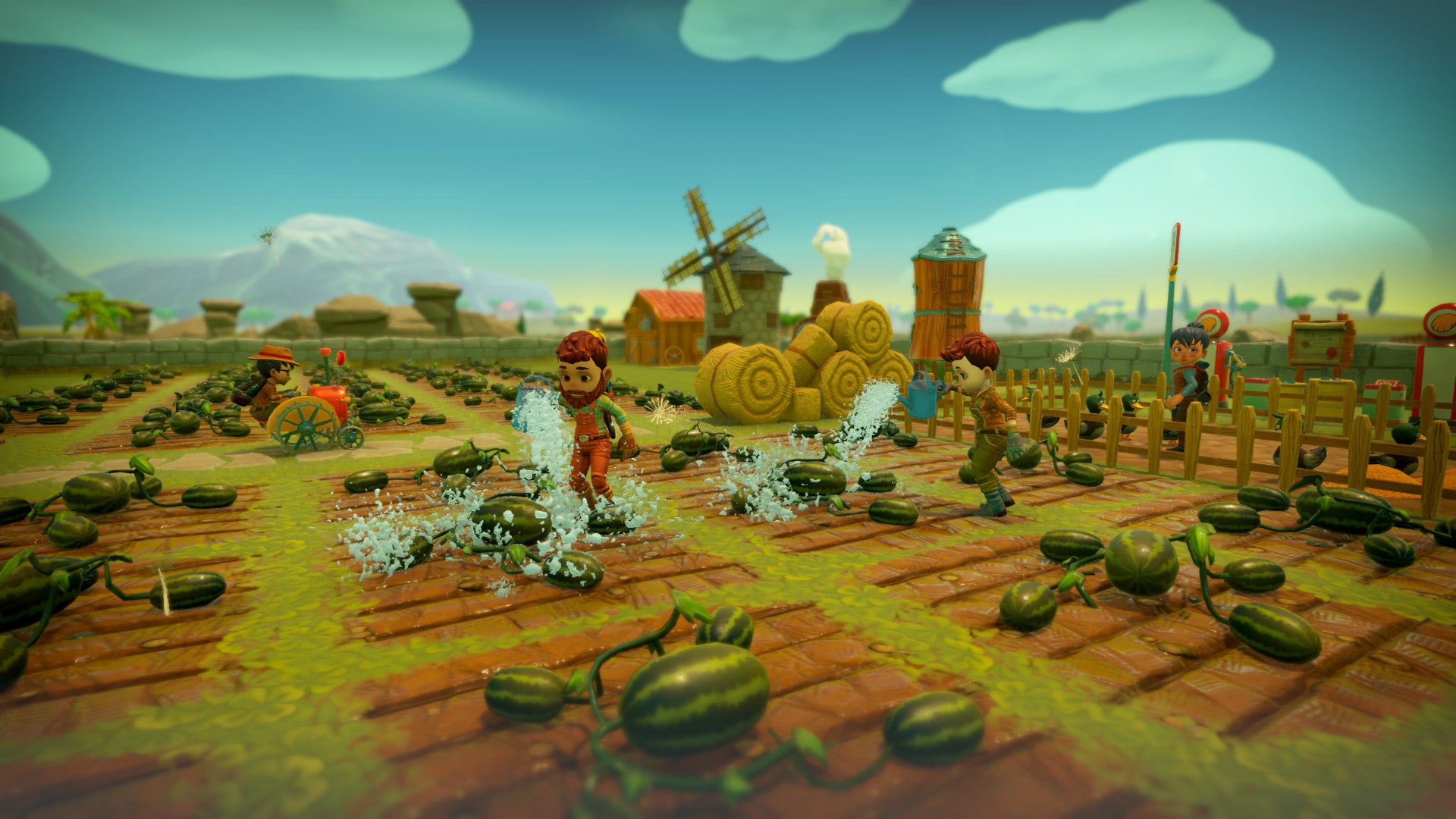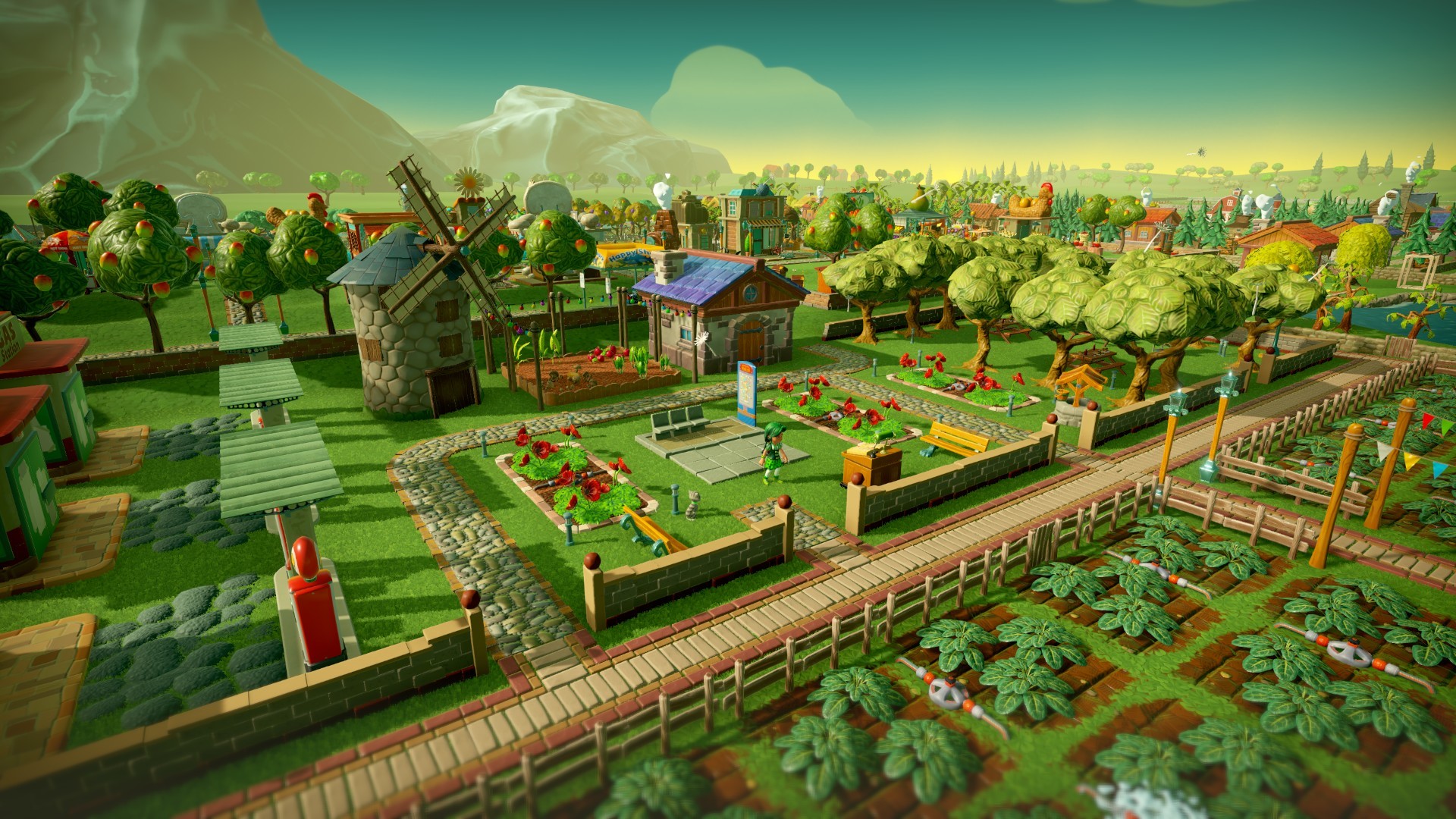When you work with 3D or video rendering, you quickly realize—excuse the tacky, car-salesman tone of this cliché—that time is actually money. Under a tight deadline with very demanding tasks, you need more than just a faster machine. You need a lot more power, and one of the main ways of getting it is to divide your task among networked machines.
It takes the actual farming process and turns it into a game for farming enthusiasts to play. You can drive tractors, woodchippers, and even ride horses as you try to make a profit from your booming farm. Farming Simulator is also multiplayer-friendly. You can fit 16 farmers into one server and work together to speed up the farming process. Why spend your money when you can download Farm Together full cracked game on this site free of charge! We present to you the new and updated Farm Together steam full game. We tested this file before to make it public, and all that we can say is ‘Grab it now’. Get Farm Together for Free (Full Version).
In my recent Mac Pro review, I mentioned that a workstation computer (whether from Apple, HP, or Dell) is designed to be good at a lot of tasks that are demanding on the CPU and, increasingly, on the GPU. But a workstation can be too much machine for some things, so often you want to free it up to use for asset production instead of saturating it with render tasks. Work stations are overkill to use as what I call 'dumb muscle.'Dumb muscle machines are like mafia button men: they lie dormant until the boss calls them in for a job and then they go beat the hell out of something—in this case, a set of 3D frames or video composites. After, they go back to sleep and wait for the next call. Dumb muscle has one job to do essentially: keep pummeling. If you put all your money and CPU cores into one box, you are going to be in a really bad spot if that machine goes down. But if you suddenly must get your workstation serviced without warning and have a lot of networked muscle, you can instantly work from a laptop and use a render server to keep your efficiency relatively high while your main machine is MIA.
I opt for the 3.0GHz 8-core Xeon E5 v2 machine because, for anything that doesn't stress more than 8-cores—almost everything but 3D rendering or certain video encoders—the 8-core would perform better than the lower-clocked 12-core. I decided to save the $1500 upgrade cost to go from the 8-core E5 v2 that would give me better performance with tasks that couldn't saturate all cores. Instead, I spent a bit of extra money to get another 10-core 3.0GHz Xeon E5 v2 and put that in a machine that will run only during V-Ray for Maya renders. If you use a 3D renderer that has network rendering support, you can use it on the host machine and the dumb muscle to quickly take down render jobs. And the resulting combo should be much faster than what you would get with a single workstation jacked to the hilt with tons of cores or dual socket CPUs.
Now, there are a lot of variables and questions to answer for anyone considering this route. If you're not much of a system builder, it's hard to know what CPU to buy, what OS to run, how to set up your host machine to talk to the muscle, and what, if any, render management software to use. While I'm not an IT guy for Pixar, I've used networked 3D renderers for a number of years and have built some personal render nodes, both Xeon and desktop-chip based. If you are looking to build a room full of HPC nodes and are concerned about heat, performance, reliability, etc.—this guide is not for you. This guide is intended for people who just want to get set up with some added networked power, to maybe learn the basics of Linux and remote administration with ssh, and to understand the foundation of networked rendering and workflows.
AdvertisementA home build vs. retail units
While I personally wouldn’t go near a home build for a workstation, we’re demanding relatively little of our render workhorse. We don’t need sound to work, we don’t need the latest video drivers, we don’t need an OpenGL-driven user interface. It just has to render, and it can’t crash while doing it. A home-built box should be perfectly fine. For the build machines I recommend, there are two main routes you can take: a beefy Xeon with lots of cores or a cheaper desktop CPU that is more for the budget-minded. A Xeon chip is designed to give you a number of things that aren't seen in a desktop processor, and it has certain advantages:
- You don't need to buy a video card for server motherboards because they have built-in VGA output (yes, VGA)
- Lower power consumption for more rendering power
- Most Xeon boards come with dual NICs for Ethernet link aggregation
- ECC RAM for dependable simulations, if you’re a scientific user who needs added data insurance
- Potentially a lot more cores and more cache
- More PCIe lanes for stuff like link-aggregated Ethernet, USB3, PCI devices, and fast RAID arrays. If you’re doing GPU rendering with more than one PCIe x16 card, you will need a Xeon to accommodate all that bandwidth

While a Xeon chip can’t be overclocked, it will give you more render power per Watt. You pay a premium for that energy efficiency, but, if you are planning on getting more of these systems, it makes a difference. Overclocking a desktop chip usually comes at the expense of energy efficiency, and you still won’t get close to the rendering power of something like a 10- or 12-core Xeon E5 v2. (That is, unless you are one of those guys with a closet that doubles as a dry ice fortress of solitude.)
Advantages to a desktop processor
If you have a tighter budget and just want a bit more help for a coming gig, a desktop chip like an i7 could be fine to get you some added oomph on the cheap. These have certain perks:
- Cheaper than Xeon and you can squeeze out more performance with overclocking
- Can double as a gaming rig if you add a decent GPU
- Cheaper non-ECC RAM
- Faster for things that don't scale well across many CPU threads. For a render machine, this is less advantageous since rendering scales well across more CPUs and cores
- More likely to get support for suspend to RAM with a gaming board than a server-oriented Xeon motherboard that might only support hibernate
The speed advantage for the desktop parts is increased because, by the time Intel releases a Xeon variant of a chip like the Ivy Bridge i7, the next faster iteration of the desktop part has come out. This means it's smartest to consider the Xeon only if you know you want more than six CPU cores, ECC memory, a ton of fast PCI express lanes, or if you want to avoid a lot of machines to manage. You can typically build two faster i7 machines for the price of a single 10- or 12-core Xeon E5 v2, but that's more RAM that can fail, more CMOSes to reset, and more potential headaches that will bite you in the ass during a deadline. I prefer to spend a bit more to get the added insurance of a Xeon, since server parts are built more to run maxed out around the clock. I am a firm believer in the saying “the miser pays twice,” and I’ve unfortunately been proven right about this on a number of occasions. Also bear in mind that many 3D renderers charge more for render nodes, so more machines also increases your cost if you’re using a renderer like Arnold or V-Ray 3.
AdvertisementPotential builds
Ars already has very good system building guides, and we have a lot of ground to cover. I'll only briefly cover the build stuff since there really isn’t one specific way to go about this. There are just a few main things to keep in mind when building some dumb render muscle:
CPU
If you’re going to get a desktop CPU, opt at least for the i7 4930K CPU. With six cores, 3.4GHz, and a $610 price tag, it offers the best balance of speed and cost for a desktop part. The 4960K will get you slightly more power (3.6GHz), but it costs $450 more. Remember that the turbo clock speeds aren’t of much concern to us because we’re using all potential threads, which only uses the base clock rate.
Disk
Since the bottleneck in our setup is the network and not the disk, we don't need to put a super fast PCIe SSD in the muscle machines. Since my render-only builds tend to get used only for CPU-heavy ops, I usually throw my older SSDs in them and that’s perfectly OK. If you’re a video editor, this would be different for you, and you’ll likely want to look into larger, faster disks and quicker networking hardware. You’ll be pushing more data, where a 3D renderer is just crunching numbers most of the time (and, if it’s an efficient renderer, it's better about caching things like textures).
Networking
For my network, I’m not using link aggregation since that requires special routers and switches. However, I can give a simple tip to speeding up your network: put your machines on a dedicated Gigabit Ethernet switch. This separates your Internet traffic from your local traffic and guarantees better bandwidth across all renderer machines and the host. Even a cheap switch will do this; my old and cheap D-Link Green Ethernet switch successfully maxes out the 100MB/s transfer rate. Don’t use wireless unless you’re using something really fast, like the newer ac spec, in all machines.
Case and cooling
For my 10-core Xeon E5 v2 case, I went with a dirt cheap and smallish Antec VSK-4000, because all it does is sit in my painting studio in the back of the house. But I didn't cut corners on the fan. I don't want it to overheat or be too loud if I need to paint in that room while my renders run. I ultimately picked up a Noctua NH-L12, which made for a pretty quiet and powerful machine. By contrast, I bought a Corsair 550D for a gaming rig a while ago and hate it because it’s so stupidly large:
Pre-K & Preschool theme ideas for learning about farms, farm animals, and crops.
Find more Farm Activities for Pre-K
Books
Click here for a complete list of Farm Books
Farm Large Motor Games
Horses Stop & Go
The children crawl around the carpet pretending to be horses as the teacher calls out “stop” and “go”. This can also be played with the children galloping.
Wheelbarrows
Children hold a partner’s feet as they walk on their hands like a wheelbarrow, taking turns being the wheelbarrow. Each pair of children has about 6 beanbags to carry (on the wheelbarrow’s back) one at a time to their destination.
Farm Literacy Activities
“Old MacDonald’s Farm Animals” Class Book
Each child makes one page and we put them all together to make a class book. The children decide on a farm animal they want to draw and the sound that animal makes and the children dictate the words to be written in the blanks:
“Old MacDonald had a farm.
E-I-E-I-O
And on that farm he had a ______.
E-I-E-I-O
With a ___ ___ here,
And a ___ ___ there,
Here a ___, there a ___, everywhere a ___ ___.
Old MacDonald had a farm,
E-I-E-I-O.”
Farm Poetry
Children choose a farm animal they want to draw. We glue the animal and the farm poem form onto a large sheet of paper. To make the poem, children dictate the words to be written in the blanks:
I am a [type of farm animal].
I can [movement].
I can [sound].
I feel [texture].
I smell [scent].
I am [emotion].
I am [color].
I am a [repeat first line].
“The Hat” Characters
After reading Jan Brett’s book The Hat, we talk about what “characters” are in a story. The second time we read the story, each child is given a character mask from the story. As we come to each character’s part in the story, the child with that character’s mask stands. After the story is read, we name each of the characters and talk about what they did in the story and what they said.
“The Hat” Character Masks
“The Hat” Clipart for Puppets
Farm Animal Bingo

Use farm animal counters to cover the letter/number/shape on the bingo cards. We use these to play alphabet bingo, number bingo, shape bingo, or rhyming bingo.
Farm Bingo Stamping Game
Read about and print the Cow and Pig Bingo Games here.
Farm Together For Mac And Cheese
Farm Roll & Write Game
Print and find directions here: Roll & Write Games
Story Retelling
This is an activity that goes with any theme. Choose a book that goes with the theme, and have the children retell the story.
Read the blog post here for details: story retelling
Farm Math Activities
Farm Pattern Block Mats

Read about and print here: Pattern Block Mat Printables. (Go to this page and look for the donkey and horse mats.)
Chicken Grid Game
Read about and print here: Grid Games
Milk Graph
Children first mix and then taste-test three kinds of milk: vanilla, strawberry, and chocolate. Children decide on their favorite kind of milk, and put their name on the graph. We count to see which had the most/least/same.
Farm Science Activities
Making Butter
We pour whipping cream into baby food jars. Children shake the jars until a ball of butter is formed in the jar. (Liquid and solid will separate). Then we spread the butter on bread to eat.
Planting Seeds
Farm Together Washing Machine
Children plant a variety of seeds in a seed sprouter. We planted 3 each of 4 different types, and later transferred them to clay pots. These were to stay in our classroom, and the children planted another seed of their choice in a clear cup that they could take home after it sprouted. We watched the growth of the plants, which encouraged lots of observation and discussion skills. The photo shows the seedlings of four types of seeds we planted: bean, corn, tomato, and watermelon. By planting four different types, children were able to observe which seeds germinate for shorter or longer periods of time. The bean and corn were the fastest to sprout, while the tomato came in third, and the watermelon took the longest to sprout.
Farm Social Studies
Farm Food
The children bring empty food packages or pictures of food from home. The children take turns showing the class what they brought. We discuss where the food comes from, and how a farm was involved in producing the food.
More
Garden Prop Box
{Dramatic Play Center}
Include: Garden gloves, Trowels, Watering can, Flower pots, Artificial plants & flowers, Bird feeder, Wind socks, Knee pads, Aprons, Straw hats, Plastic vegetables
Rhymes
Nursery rhymes that go well with a Farm Theme:
- Little Boy Blue
- Little Bo Peep
- I Hop on My Horse
Farm Together Mac Crack
Look for printable posters of these rhymes on the Nursery Rhymes Page.
Songs
- Down on Grandpa’s Farm, by Raffi (Download on iTunes)
- Old MacDonald Had a Band, by Raffi (Download on iTunes)
- Did You Feed My Cow?, by Ella Jenkins
Find more Farm Activities for Pre-K
Resources
Links
Don't worry - we never sell or share email addresses!
